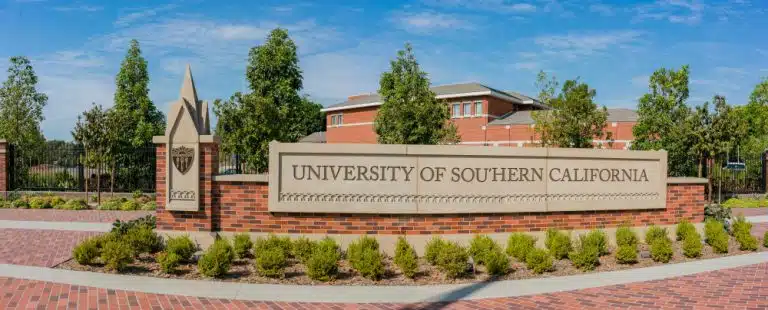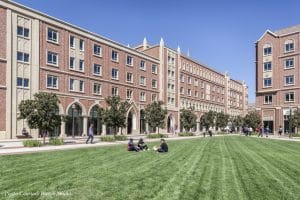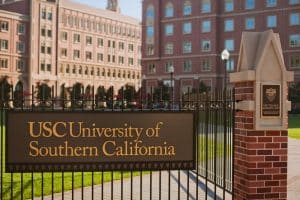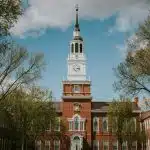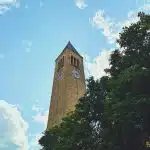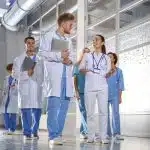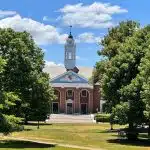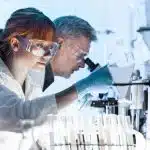The University of Southern California (USC) is a private research university founded in 1880, making it one of the oldest and most prestigious institutions in the region. But where is USC located?
USC has a main campus in Los Angeles but also has other campuses, accommodating students from certain disciplines, such as medicine and business.
In this article, we’ll talk more about USC’s main location, its surrounding areas, and transportation options. We’ll also mention other USC campuses and how they differ from the main one.
- Where Is USC’s Location?
- Other USC Campuses
- Places to Check Out Near USC
- USC Transportation Options
- Frequently Asked Questions
- Takeaways
Where Is USC’s Location?
USC’s main campus is located in the city of Los Angeles, California, specifically 3551 Trousdale Pkwy, Los Angeles, CA 90089, in the University Park neighborhood. This places USC in one of the most dynamic and culturally diverse cities in the country.
The beautiful USC campus spans 226 acres and features a blend of historic and modern architecture, iconic red-brick buildings, lush courtyards, and cutting-edge facilities in a lively urban setting.
As a student, you’ll be part of USC traditions, such as the Senior Fountain Run, a rite of passage that symbolizes the end of your undergraduate studies. You’ll meet Traveler, the white Andalusian horse that serves as the university’s mascot. You will also see the Victory Bell, a 295-pound brass bell gifted in 1939 by the UCLA Alumni Association that symbolizes USC’s athletic triumphs.
We’ll discuss other major areas of the USC campus that are worth knowing about.
USC Village
The USC Village is a 15-acre extension of the University Park campus that opened in 2017 and now serves as a central hub for student life, dining, and retail.
The Village features several residential colleges designed to enhance student living and learning experiences. Each of them has its own unique character and focus:
- McCarthy Honors Residential College. Houses freshmen honors students, this college will receive mentoring by top university faculty and have unique opportunities to learn from other highly influential people. You’ll be guided to fully develop your leadership, scholarship, and citizenship abilities.
- David C. Bohnett Residential College. Focuses on solving social justice and community service through entrepreneurship. You’ll engage with and think of innovative solutions for various social issues—from homelessness to college access.
- Cale Residential College. Focuses on global perspectives. You’ll build intercultural competency and participate in dialogue on the ever-changing global landscape.
- Nemirovsky Residential College. Aims to use green living practices, educational activities, and societal engagement to build awareness of the principles of environmental, social, and economic sustainability.
- Ghada and Ray Irani Residential College. Here, you will have a strong understanding of performance science. That means you’ll learn about brain and body function, human behavior, psychology, emotion, and leadership with the goal of maximizing your performance as an individual and as a member of society.
- Cowlings Residential College. All about the arts and culture of Los Angeles. You’ll explore the many artists (from filmmakers to musicians) who have lived in LA.
- McMorrow Residential College. For students with a passion and interest in technology, science, and design. It focuses on design and innovation and hopes to encourage students to solve global challenges through creativity, innovation, and novelty.
- Ilium Residential College. Houses Sophomore Honors students, who participate in programs and conversations that promote innovative thinking and challenge them to explore other branches of knowledge.
Despite being primarily known for its modern, high-quality student housing options, the USC Village also has a diverse range of restaurants and shops (like Trader Joe’s!), offering convenience and a lively atmosphere for students and the surrounding community. You can even find a fitness center here.
USC museums
The beautiful USC campus is home to several museums that enrich the cultural and educational experience for students, faculty, and the wider community. These museums show diverse collections of art, history, and cultural heritage.
USC museums is made up of the University Collections Management Compliance Program and two museums: Fisher Museum and Pacific Asia Museum.
Fisher Museum
The Fisher Museum was established in 1939 and is one of Los Angeles’ oldest art institutions.
It houses a diverse collection of over 1,800 works, ranging from Renaissance to contemporary art. It also features rotating exhibitions showcasing works from renowned artists and emerging talents.
The Fisher Museum serves as a hub for artistic expression and engagement, offering educational programs and events for the campus community and the public.
Pacific Asia Museum
The Pacific Asia Museum is actually located off-campus in Pasadena. It was established in 1971, but acquired by USC only in 2013.
This museum focuses on the art, culture, and history of Asia and the Pacific Islands. The collection features over 15,000 objects, including sculptures, textiles, ceramics, and contemporary art, offering a unique perspective on diverse cultures.
It offers programs that celebrate the diversity of Asian and Pacific cultures, such as performances, lectures, and festivals.
Other USC Campuses
Other USC campuses are also located throughout the country, such as Sacramento, California and Washington, D.C. We’ll talk about the most notable ones below:
USC Health Sciences Campus (HSC)
The USC Health Sciences Campus is a separate campus from the main University Park campus, located east of downtown Los Angeles. As the name suggests, it’s dedicated to health sciences education and research, housing health-related programs and several advanced research facilities.
Below are the schools on the HSC campus:
- Keck School of Medicine. USC’s premier medical school and renowned for research in areas like cancer, neuroscience, and global health. Students gain hands-on experience at top-tier facilities like Keck Medical Center and USC Norris Cancer Center.
- Herman Ostrow School of Dentistry. Known for its state-of-the-art dental simulation labs and community outreach clinics, it provides comprehensive education and training in dentistry, oral and maxillofacial surgery, and dental hygiene.
- Alfred E. Mann School of Pharmacy and Pharmaceutical Sciences. Offers programs focused on pharmaceutical sciences and healthcare innovation. Its research strengths include drug development, regulatory science, and personalized medicine.
- Chan Division of Occupational Science and Occupational Therapy. Educates and trains occupational therapists to help individuals of all ages achieve independence and well-being. Its research focuses on improving quality of life through innovative therapies.
- Division of Biokinesiology and Physical Therapy. Offers a comprehensive curriculum in physical therapy and lets students train in state-of-the-art facilities and gain experience in sports medicine and patient care.
- Leonard Davis School of Gerontology. The nation’s first school dedicated to aging studies, offering interdisciplinary programs in gerontology and aging services management. Research areas include longevity, dementia care, and elder policy.
- Suzanne Dworak-Peck School of Social Work. Offers graduate programs in social work and nursing, focusing on community well-being and mental health. Research emphasizes trauma care, homelessness, and social justice.
HSC students benefit from hands-on learning experiences, clinical rotations, and mentorship opportunities with leading medical professionals. You get to serve the surrounding community through outreach programs and clinics, providing quality care to underserved populations.
USC Capital Campus
The USC Capital Campus is a big step forward for the university, marking its first physical presence outside of California. The institution is found in the heart of Washington, D.C.’s Dupont Circle neighborhood. This positions USC at the center of California’s political and legislative activity, offering students and faculty unique opportunities to interact with policymakers and contribute to state and national discourse.
The campus offers Master of Public Administration (MPA) and Master of Public Policy (MPP) programs by the USC Price School of Public Policy.
Most of its programs for undergrads, graduates, and executives provide immersive experiences where you get hands-on direct access to influential leaders and organizations and the chance to engage with discourse on national and global issues.
For example, the Dornsife Washington DC Program for undergrads gives you a semester-long opportunity to study courses like foreign affairs, the political process, and national security decision-making right in the capital.
Meanwhile, the Rossier Global Executive Doctor of Education is for senior educational leaders, policymakers, administrators, and other professionals who are trying to improve education on a large scale. This program teaches you how strategic use of policy, innovative practice, assessment, and social entrepreneurship lets you create large-scale improvements across educational systems.
Places to Check Out Near USC
The neighborhoods surrounding USC offer a rich blend of culture, entertainment, and history, providing students with many opportunities to explore and enjoy Los Angeles.
Exposition Park
Exposition Park is a cultural and recreational hub that’s adjacent to USC. Some key attractions you can find here are:
- California Science Center. Home to the Space Shuttle Endeavour.
- Natural History Museum of Los Angeles County. Featuring fascinating exhibits on dinosaurs and local wildlife.
- Los Angeles Memorial Coliseum. A historic sports venue and home to USC Trojans football games.
- Exposition Park Rose Garden. A serene space perfect for relaxation or study breaks.
Downtown Los Angeles (DTLA)
DTLA is just a few minutes from USC and offers a dynamic mix of history, entertainment, and dining. Some attractions you should definitely check out are:
- The Broad Museum. A contemporary art museum with works by artists like Yayoi Kusama and Jeff Koons.
- Grand Central Market. A food hall featuring global cuisines, from tacos to ramen.
- LA Live. A hub for concerts, events, and dining near Crypto.com Arena.
- Walt Disney Concert Hall. Stunning architecture and world-class performances.
- Grand Park. Features events, festivals, and stunning city views.
South Los Angeles
South Los Angeles is the immediate neighborhood around USC. It’s a diverse and historic neighborhood with a rich cultural heritage. Community highlights include farmer’s markets, street art, and lively festivals—but other local gems are:
- Cocoa Grinder Café. A cozy spot for coffee and pastries.
- Chichen Itza. A popular Mexican restaurant offering authentic Yucatecan cuisine.
- Museums. Natural History Museum of Los Angeles County, California Science Center, Exposition Park Rose Garden
Hollywood
Hollywood is 20 minutes from USC, but it’s definitely a must-visit if you get the chance! Areas you can explore are:
- Hollywood Walk of Fame. A stroll through star-studded sidewalks.
- TCL Chinese Theatre. A historic venue hosting movie premieres and tours.
- Hollywood Bowl. An iconic outdoor amphitheater for concerts and events.
Other recreational opportunities
Outdoor enthusiasts can explore nearby parks, hiking trails, and sports facilities, such as:
- Griffith Park. Ideal for hiking and visiting the Griffith Observatory.
- Runyon Canyon. A favorite for scenic trails with views of Los Angeles and the Hollywood sign.
The USC area and its surroundings are rich in dining options too. Some restaurants you can try are:
- Howlin’ Ray’s (Chinatown). Known for its spicy Nashville hot chicken.
- Bacari W. Adams. A popular student hangout with Mediterranean-inspired small plates.
Meanwhile, a short drive west brings you to the iconic beaches of Los Angeles, namely:
- Santa Monica. Known for its lively pier, expansive beach, and trendy Third Street Promenade.
- Venice Beach. Famous for its bohemian vibe, Muscle Beach, and colorful boardwalk.
USC Transportation Options
Reaching USC is actually convenient, whether you’re traveling by car, public transportation, or air.
Car
If you’re using a car, USC is easily accessible via several major highways—namely Interstate 10 (I-10), Interstate 110 (I-110), and Interstate 101 (I-101).
USC offers several parking garages and lots on and near the campus, including parking near key academic buildings, residence halls, and the USC Village. The rates differ depending on the parking area, with some lots offering hourly rates, while others have daily maximum charges. Visitors can park in designated visitor lots, typically near the main entrances. A parking map is available online for easy navigation.
Public transportation
You can also easily get to USC using the Los Angeles Metro and bus systems:
- Metro Expo Line. The Expo Park/USC station is located just a few blocks from the main campus. This light rail line connects the campus to key locations in Los Angeles, including Downtown LA and Santa Monica.
- Metro Bus Lines. Several Metro bus lines serve the USC area, including lines 37, 43, and 204, which provide easy connections throughout the city.
- USC Tram Service. For students and faculty, the campus offers a tram service that connects the main campus to nearby locations such as the Health Sciences Campus.
- Ride-sharing services. Uber and Lyft are readily available and offer convenient transportation options.
Airplane
For those who take the plane back and forth from their home states/countries outside of the semester, USC is conveniently located near two major airports:
- Los Angeles International Airport (LAX). Approximately a 30-minute drive from USC (12 miles). LAX offers domestic and international flights, making it the most common entry point for travelers.
- Bob Hope Airport (Burbank). About 15 miles north of USC, this smaller airport offers flights throughout the U.S. and is often less crowded than LAX.
Once you’re inside the campus, you’ll find that USC has wide walkways, green spaces, and clear signage, making it easy for visitors and students to navigate on foot. The campus provides accommodations for individuals with disabilities, including wheelchair access, elevators, and accessible entrances in most buildings.
USC also supports cycling with bike racks throughout the campus and a bike-sharing program.
Frequently Asked Questions
1. What GPA is needed to get into USC?
You should ideally have a GPA of 3.87 to get into USC since that’s the average GPA of admitted students.
2. What is USC famous for?
USC is famous for its creative programs, particularly Film and Television Production. In fact, the institution’s School of Cinematic Arts is recognized as one of the best film and television production programs in the world.
3. How hard is it to get into USC?
USC is highly selective with an acceptance rate of 9.2%, so it can be quite tough to get into it.
4. What city is USC in?
The main campus of USC is in Los Angeles, California.
Takeaways
The University of Southern California (USC) is located primarily in University Park in Los Angeles.
- USC’s University Park campus blends historic and modern architecture. Aside from the schools, you’ll also find the USC Village (which houses residential colleges and other dining and retail options) and USC Museums.
- Two other notable USC campuses are the Health Sciences Campus just east of downtown Los Angeles and the USC Capital Campus in Washington, D.C.
- The University Park campus is found in a lively neighborhood surrounded by other vibrant areas where you can explore museums, relax at beaches, and try new food.
- USC is very accessible regardless of whether you’re traveling by car, air, or public transportation. You can check the official USC website for the most up-to-date information on transportation, parking, and campus accessibility.
- USC admissions are quite competitive. If you want to increase your chances of being accepted to experience the benefits the campus has to offer, a private consultant can give you tips on how to improve your academics and extracurriculars to boost your college application.

Eric Eng
About the author
Eric Eng is the Founder and CEO of AdmissionSight, graduated with a BA from Princeton University and has one of the highest track records in the industry of placing students into Ivy League schools and top 10 universities. He has been featured on the US News & World Report for his insights on college admissions.

